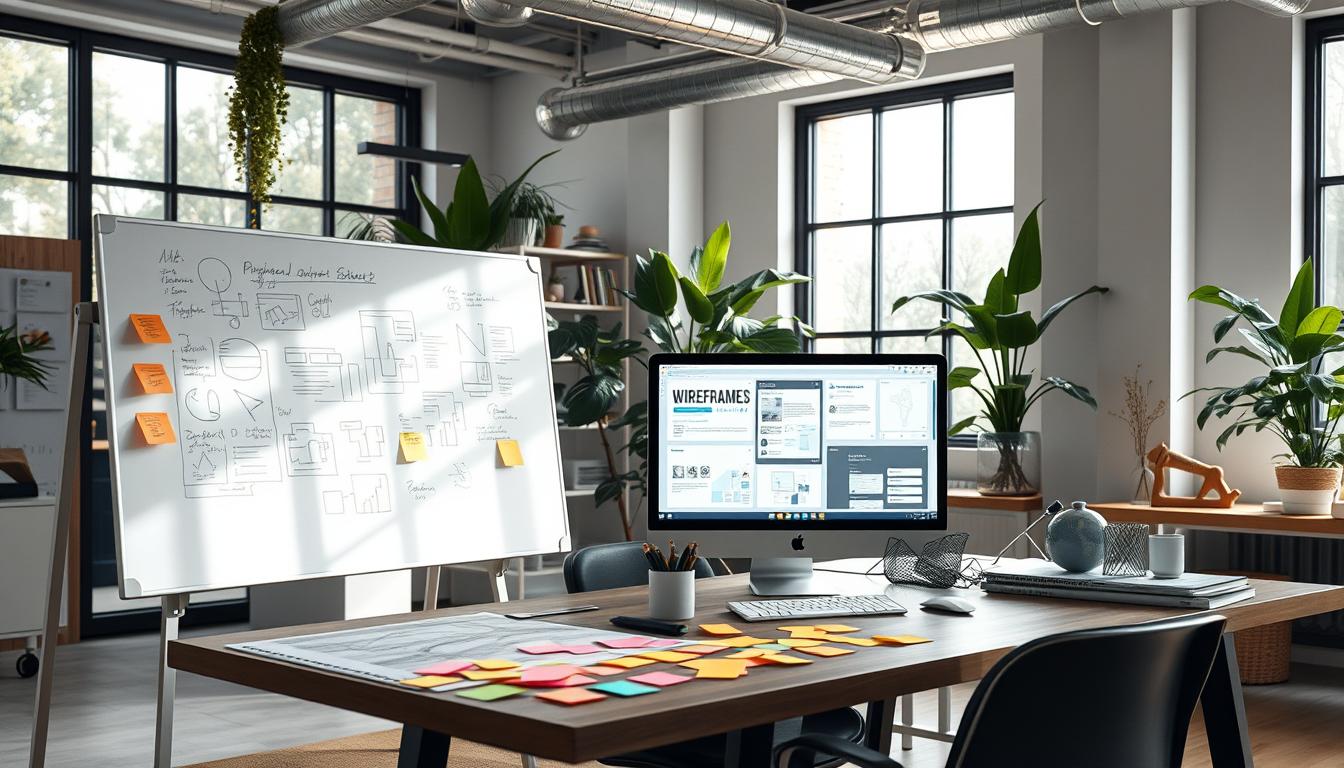“Design is not just what it looks like and feels like. Design is how it works.” – Steve Jobs, Co-founder of Apple Inc.
At ctrls.tech, we focus on making businesses better by putting users first. As top Human-Centered Design Consultants, we mix design thinking, business strategy, and financial smarts. This way, we build digital experiences that boost adoption and growth. Our Motivational UX™ framework uses research from different fields to find solutions that put customers first.
If you want to improve your products, change how customers feel, or start new businesses, we’ve got you covered. Our User Experience Design services give you the insights and plans you need to win. We get to know your users’ needs, what motivates them, and what hurts them. Then, we create solutions that make customers happy and help your business grow.
Key Takeaways
- Leverage human-centered design expertise to drive business growth and innovation
- Adopt a customer-centric approach that addresses pain points and maximizes engagement
- Unlock the power of Motivational UX™ to create experiences that inspire customer loyalty
- Discover unnoticed opportunities and mitigate risks with a comprehensive design consulting service
- Enhance your competitive edge by delivering exceptional user experiences that set you apart
Understanding Human-Centered Design Principles
Human-centered design (HCD) puts real people at the heart of the design process. It’s a creative and evidence-based method. It aims to understand users’ pain points, context, preferences, and goals.
This approach focuses on making products and services intuitive and convenient. At its core, HCD values empathy, collaboration, and continuous feedback. It ensures solutions meet the needs of the target audience.
What is Human-Centered Design?
HCD is a design philosophy that tackles the root causes of user problems, not just symptoms. It uses user research and usability testing to create solutions. These solutions are intuitive, accessible, and user-friendly.
This approach aims to produce products and services that meet functional requirements. It also enhances the overall human factors and user experience.
The Importance of Empathy in Design
Empathy is key in HCD. It helps designers avoid making false assumptions about user needs. It fosters a meaningful connection with the target audience.
By understanding user perspectives, designers can uncover latent needs. They can develop solutions that resonate on an emotional level. This empathetic mindset shapes every stage of the design process.
Key Elements of Human-Centered Design
The HCD approach focuses on addressing the root causes of problems. It ensures usability and accessibility. It also incorporates continuous feedback from users throughout the design process.
Furthermore, HCD emphasizes the interconnected nature of systems. It encourages designers to consider the broader context and implications of their solutions.
“Human-centered design emphasizes the importance of designing products that enhance lives and add to pleasure and enjoyment, aiming to produce products that are successful and loved by customers.”
By embracing these principles, HCD consultants can create innovative and impactful solutions. These solutions truly meet the needs of the target audience. This approach has proven to be a game-changer in various industries.
It drives customer satisfaction, loyalty, and business success.
Choosing the Right Human-Centered Design Consultant
When picking a human-centered design consultant, look for those with skills in Interaction Design, Product Design, and business strategy. They should also know about financial analytics. Look for deep design knowledge, a full range of design services, and a history of innovation and change.
Qualities to Look For
The ideal consultant should know a lot about user research, service design, and digital design. They should also be good at co-design. It’s important they have experience in your field and can mix different research types to find key insights. They should also be able to make a space where everyone feels safe and included, and improve things based on what users say.
Questions to Ask Potential Consultants
When you’re looking at potential consultants, ask about their methods for user research and design. Find out if they know your industry well and how they mix different research types. Ask about their approach to making a collaborative and safe space, and how they use user feedback to improve things.
| Qualities to Look For | Questions to Ask |
|---|---|
|
Deep design expertise Complete end-to-end design service offering Proven track record of driving innovation and cultural change |
What is your approach to user research, service design, digital design, and co-design? How do you blend qualitative and quantitative research methods? How do you create safe and inclusive environments for collaboration? How do you approach iterative improvement based on user feedback? |

By carefully looking at what they offer and asking the right questions, you can find a human-centered design consultant. They will create innovative solutions that meet your specific needs and goals.
The Process of Human-Centered Design
Human-centered design is all about working together and improving things over time. It focuses on what users need and want. This approach, led by innovators like ctrls.tech, is changing how we make digital products.
Steps Involved in Human-Centered Design
The design process has several important steps. Each one helps us understand what users need and make things better. These steps include researching users, coming up with ideas, making prototypes, and testing them.
By using both qualitative and quantitative methods, designers get deep insights. They learn about user behaviors and problems. This helps them create experiences that really connect with people.
Collaborative Approaches to Design
At ctrls.tech, we think teamwork is key. We bring together stakeholders, experts, and users. This way, we make solutions that really meet people’s needs.
This team effort makes sure everyone’s voice is heard. It leads to designs that are more complete and easy to use.
In the design journey, we always look to improve based on what users say. By making changes and refining our designs, we meet our customers’ changing needs.
The human-centered design way has changed how we think about Customer Experience and digital innovation. By focusing on what users need, companies like ctrls.tech create solutions that not only solve problems but also make customers happy and engaged.
Benefits of Engaging a Human-Centered Design Consultant
Working with a Human-Centered Design Consultant can greatly benefit businesses. They help improve user experience and boost customer satisfaction. These experts focus on what users need and want, making products and services better for them.
Enhanced User Experience
Human-Centered Design Consultants really get to know what users need. They do lots of research and use empathy to find out what problems users face. Then, they come up with creative solutions that users love.
This approach leads to better experiences. Users are more engaged, products get used more, and businesses make more money.
Increased Customer Satisfaction
By putting users first, these consultants make products that meet customer needs. This makes users happy because they feel heard and valued. Happy customers stick with a brand and tell others about it.
“Good design is actually a lot harder to notice than poor design, in part because good design fits our needs so well that the design is invisible, serving us without drawing attention to itself.” – Don Norman, Renowned Human-Centered Design Expert
Getting a Human-Centered Design Consultant can change a business for the better. They help find new ways to stand out, avoid problems, and make sure new ideas work well. By focusing on the user, these experts help businesses be more customer-focused and successful.
Real-World Applications of Human-Centered Design
Human-centered design has changed many industries. In healthcare, MedStar Health worked with design experts to make patient care better. They used insights from patients to improve their services. Nebraska Medicine also teamed up with designers to tackle healthcare challenges.
Case Studies in Various Industries
Design thinking is not just for healthcare. The Victorian Department of Transport and Planning saw big improvements thanks to design consultants. At ctrls.tech, we’ve helped many companies, from finance to education, make their products better. This has led to happier customers and more growth.
Success Stories from My Experience
We’ve used Design Thinking and Usability Testing to help many clients. For example, a fintech company’s mobile app became 30% more engaging. We also helped a university improve their online learning platform, boosting student satisfaction by 25%.



